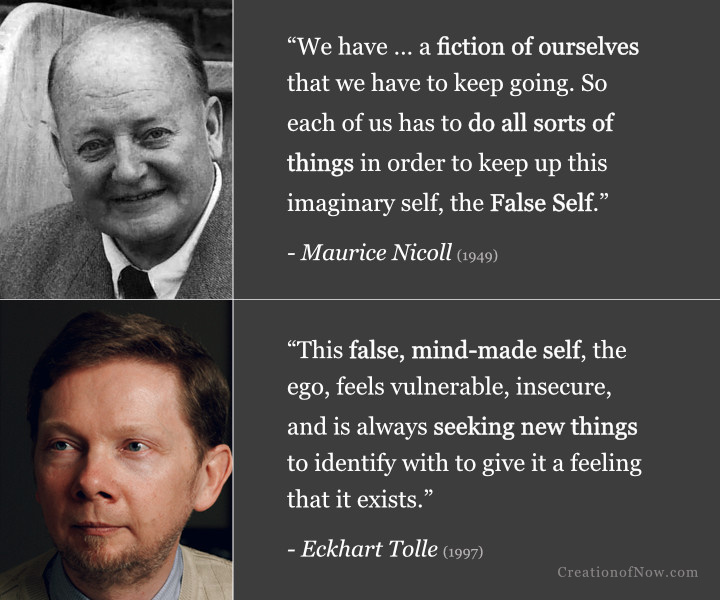All images on this site comparing similar statements by Eckhart Tolle and Maurice Nicoll on the topic of the “false self” are gathered here. Cycle through the pics using the forward and back arrows at the top. To view quotes in other categories, use the links at the bottom of the page.

The false self/personality acts as a psychological substitute for our true or essential self, the authors say.
Read the article this image was featured in here.

The false self/personality is formed by the environmental/cultural influences/conditioning of our upbringing and the imaginary idea or image we form of ourselves, the authors convey.
Read the article this image was featured in here.

The egoic or imaginary self that rules us is a “mental construct” or “composed of imagination” Tolle and Nicoll respectively tell us.
Read the article this image was featured in here.

Our imaginary or illusory “I” or “self” is the cause of many misunderstandings or misinterpretations, creating confusion inwardly and externally.
Read the article this image was featured in here.

The false self is the source of much of the dysfunction or misunderstandings occurring in human relationships, the authors say.
Read the article this image was featured in here.

Because the false self is only a fiction/mind-made, we constantly feel compelled to do things to maintain it, we’re told.
Read the article this image was featured in here.

Living through the False Personality/ego creates underlying fear, the authors say, even if it’s hidden. Striving to maintain something unreal brings ongoing anxiety/insecurity about losing it.
Read the article this image was featured in here.

The desire to sustain the ego or false personality creates an unending psychological struggle or expense because one is essentially striving to maintain a fabrication, the authors suggest.
Read the article this image was featured in here.

The illusory or imaginary “I” or identity we cling to, and its fictitious self-image/pictures, will start to dissolve or collapse when brought into the light of consciousness, the authors say.
Read the article this image was featured in here.

We mistake the false self for who we are, the authors say, but when we observe or recognize what’s in us clearly, our illusory/imaginary self begins to dissolve.
Read the article this image was featured in here.

To release oneself or withdraw—psychologically—from one’s identification with the false self is a great relief, the authors suggest.
Read the article this image was featured in here.

The pseudo self or phantom self wants to fortify itself—the idea or image of who we think we are, Nicoll and Tolle say.
Read the article this image was featured in here.

The imaginary/illusory I or identity is at least partly sustained, Nicoll and Tolle suggest, by the erroneous importance or perception we give to “the word ‘I'”
Read the article this image was featured in here.

Nicoll and Tolle both explain that a person can discover the truth of who they are only by gradually identifying what they are not.
Read the article this image was featured in here.

Allowing one’s false sense of self to diminish—and thus become less or nothing in relation to what we thought we were—draws real “I” or Being to us, the authors suggest.
Read the article this image was featured in here.
Identification | Psychological Projection
The False Self | Essence and Personality
The Now | Eckhart Tolle & Barry Long
The Time/Pain Body & Emotional Centre/Body
View main quote image categories:
Self-Observation | Spiritual Psychology
Negativity Within | Law of Opposites
